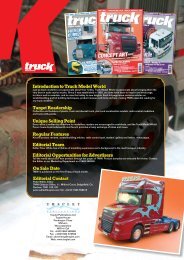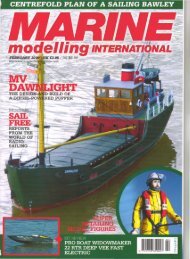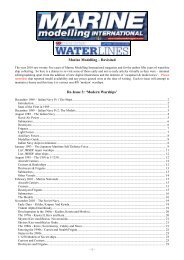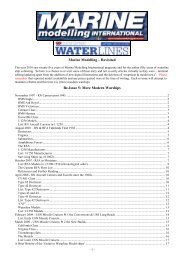Marine Modelling â Revisited Re-Issue 2: 'Foreign Warships'
Marine Modelling â Revisited Re-Issue 2: 'Foreign Warships'
Marine Modelling â Revisited Re-Issue 2: 'Foreign Warships'
Create successful ePaper yourself
Turn your PDF publications into a flip-book with our unique Google optimized e-Paper software.
(see photos). The unmodified and largely immobile Sao Paulo was sold in 1951 but lost at sea on the way to Spanish<br />
breakers; Minas Gerais was broken up in 1954. A model of the class as completed is Navis NM801, listed as Sao Paulo,<br />
whilst the modernised Minas Gerais has been produced by Star (R75).<br />
Chile<br />
Two battleships were ordered from<br />
Armstrongs of Newcastle in 1911; the first<br />
of these - Almirante Latorre - was purchased<br />
by the Royal Navy in 1914 serving as HMS<br />
Canada until 1920. Sistership Almirante<br />
Cochrane was converted to become the<br />
carrier HMS Eagle (as described last<br />
December). With the war over, Chile<br />
wanted to re-purchase both but with the RN<br />
unwilling to release the ex-Cochrane, the<br />
Almirante Latorre alone was returned. She<br />
Argonaut Almirante Latorre<br />
was refitted by Devonport Dockyard circa<br />
1929-31 when bilges were fitted and a<br />
catapult installed on the quarterdeck. As late as 1950 the main engines were overhauled and radar added. The following<br />
year a fire in the engine room immobilised the ship and she remained unrepaired. In 1959 she was towed to Japan and<br />
scrapped. Navis have produced a model of the ship as HMS Canada (catalogue NM117) and this could serve as the<br />
Almirante Latorre during the period 1920 to 1928.<br />
France<br />
Like most navies French dreadnoughts were developed in two stages, the pre-WW1 Courbet and Bretagne classes and the<br />
second generation Dunkerque and Richelieu classes. The four ships of the Courbet class were completed in 1913/14 and<br />
carried twelve 12” guns (six twins, including two wing turrets) on 25.579 tons with a top speed of 20 knots. One, the<br />
France, was lost in 1922 when she hit an uncharted rock, but the remainder were modernised during the 1920s at which<br />
time the two forward funnels were trunked. The Jean Bart was re-named Ocean in 1936 before becoming a training ship<br />
two years later; her two<br />
sisters assumed this role in<br />
1939, before falling into<br />
British hands in 1940.<br />
Courbet was used as part of<br />
the Mulberry breakwater in<br />
1944 and the other two were<br />
scrapped post war (Paris<br />
surviving at Brest until<br />
1950). The Bretagne class<br />
(of 3) introduced the larger<br />
Argonaut Provence<br />
13.4” gun with a more<br />
efficient arrangement of five<br />
centreline<br />
turrets;<br />
displacement increased to 26,180 tons and speed remained at 20 knots. All entered service in 1916. All were progressively<br />
modernised to increase gun range (1921-23), provide part oil burning (1927-30) and finally in 1932 - 1935 to improve<br />
propulsion, protection and armament (new guns, albeit of the same calibre). The Provence was further modified with the<br />
midships turret replaced by a catapult and hangar with four seaplanes carried. Uncertain, with the best will in the world, of<br />
their ability to deny the ship to the Germans, Bretagne was sunk by the RN at Mers-el-Kebir in 1940; she was later raised<br />
and scrapped. Provence was also damaged at Mers-el-Kebir but eventually towed to Toulon where the Germans, in 1943,<br />
removed her main guns for use as coastal defence batteries. The hull was scuttled as a blockship but again raised and<br />
scrapped post-war. The Lorraine was at<br />
Alexandria in 1940 and remaining under<br />
national command she joined the Free French<br />
Navy in 1943; after the war she became a<br />
training ship and was finally broken up 1954.<br />
The fast battleships Dunkerque and<br />
Strasbourg were laid down in the early 1930s<br />
and completed in 1935 and 1936<br />
respectively. The design was unusual in that<br />
the main guns - eight 13” in two quad turrets<br />
- 8 -<br />
Argonaut Lorraine







